
Search
The Renewable Energy site for Do-It-Yourselfers
An Experimental PEX
Solar Water Heating Collector
|
These pages cover an experimental
solar collector for heating water that uses PEX pipe instead of the usual copper
pipe.
This construction has the potential
to dramatically reduce cost, and also to make the collector much easier to build
with common DIY skills.
Solar water heating collectors are
used to heat water for domestic use and also to provide hot water
for space heating. The most common commercial collectors consist of
copper fins that are soldered or welded to copper pipes.
In operation, the sun heats the fins, which in turn transfer their heat to the
copper pipes and then to the water flowing through the pipes. This is a
good design that works efficiently and has a long track record. But, the design, does have some
drawbacks from a build-it-yourself viewpoint: 1) copper has become very
expensive, 2) soldering the copper pipes to the fins is time consuming and not a
common DIY skill.
|
|
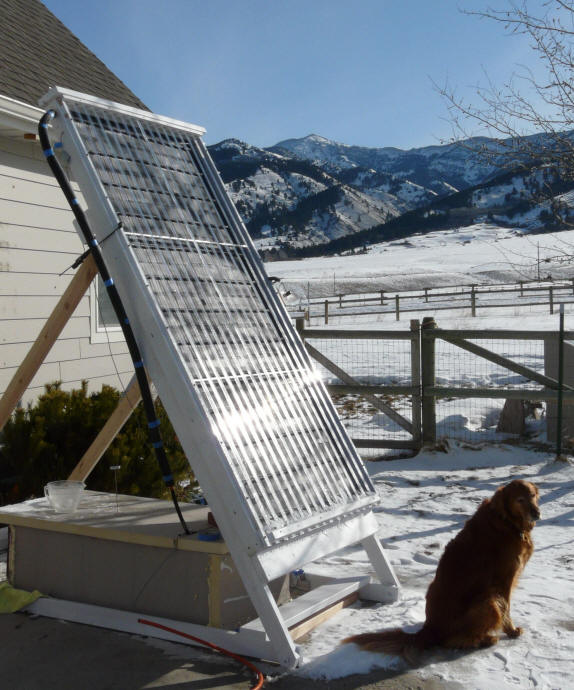
The prototype test collector using PEX-AL-PEX
This design uses
aluminum fins instead of copper fins, and uses PEX (actually PEX-AL-PEX) instead
of copper pipe. Much effort is put into providing a good thermal bond
between the PEX tubes and the aluminum fins.
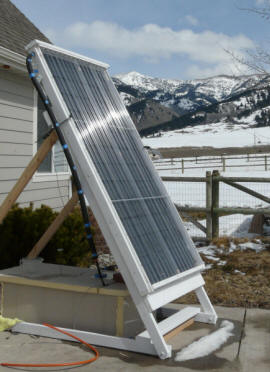 |
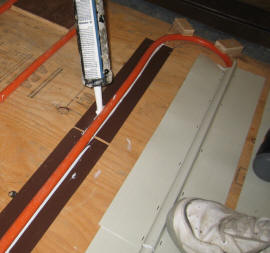
PEX pipe with narrow alum strip under,
and wider, grooved strip over.
Silicone fills any tiny air pockets.
|

Aluminum fins must fit very snugly over
the PEX tubing. |
The potential advantages of this construction:
- The collector is easy to build using ordinary tools and skills -- its a
fairly easy DIY project.
- The collector is about 1/5 th the cost of commercial collectors ($140 vs
$700 to $900 for a 4X8 collector)
- Materials to build the collector are locally available -- the cost and
hassle of shipping large assembled collectors is avoided.
For one case I looked at, shipping on a commercial collector was more than
the total cost of materials for the PEX collector!
There are also potential
disadvantages -- the main ones being:
-
PEX-AL-PEX does not withstand
temperatures as high as copper does. For practical purposes, it is
probably limited to temperatures around 230F. This means that the
stagnation temperature of the collector must be controlled -- see below for
more on this.
-
The PEX collector is not as
efficient as a copper commercial collector.
My testing indicates that the PEX
collector will have about 84% of the heat output of a conventional, all
copper collector.
-
PEX is subject to
deterioration when subjected to sunlight (UV light).
So, it must be protected from UV exposure -- this is pretty easy -- see
below.
You might also want to look at a
similar collector that uses
copper tubes here...
And, the PEX collector that I used
for our solar water heating system here...
Design Overview
The collector uses a PEX-AL-PEX to convey the heat
transfer fluid and to pick up heat from the collector. The PEX is
laid out in a serpentine pattern from the inlet end of the collector
to the outlet.
Aluminum fins that are grooved to snugly fit the PEX tubing are applied
over the tubing with silicone used to fill any very small gaps and improve
the thermal connection.
A narrower strip of flat aluminum is used under the PEX tubing to
provide some additional heat transfer area into the bottom of the tube.
In this way, the tube essentially surrounded with aluminum.
A lot of care is taken to maximize the quality of the thermal
connection between the PEX and the aluminum. |
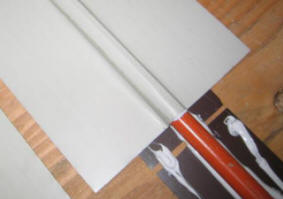 |
A part of the cost saving
for this design comes from using plastic instead of metal parts. Plastics
have lower temperature capabilities, so, an important part of the design has
to do with protecting the plastics from being damaged by high temperatures.
If you are going to build one of these, it is important to understand the
steps taken in the design to protect the plastics from being destroyed by high
temperature conditions.
Corrugated polycarbonate glazing
provides a high transmittance, high temperature, long life glazing at a low
cost. It is important to use polycarbonate glazing, as it has the high
temperature capability that is required.
The back of the collector is
insulated with high temperature, high R value polyisocyanurate rigid foam
insulation.
All of the materials are likely to be available at a good lumber yard or big box
hardware.
Prototype Construction Details
The construction is very simple.
-
The frame is made with 2 by 4's
and a 2X6 for the top sill.
-
The glazing is corrugated SunTuf
polycarbonate ($1.10 per sqft at HD)
-
The absorber is a sheet of
plywood with the PEX-AL-PEX run down it in a serpentine pattern. The
aluminum fins are then applied over the PEX and stapled in place.
Only a single length of PEX is used this way - no plumbing fittings in the
collector.
-
A sheet of 1 inch polyiso
insulation is set into the back of the frame to insulate the back.
Much
much more on the
construction here ... <----------
For the prototype, I used PEX -
Aluminum-PEX -- why PEX-AL-PEX? ...
Prototype Performance
Two types of performance testing have
been done on the collector:
-
Some tests that were carried out
with small (2 sqft) collector panels that include a baseline collector using
traditional commercial collector construction, this PEX collector, and a
hybrid copper tube collector using aluminum fins.
I believe that these tests give the best indication of the kind of
performance that can be expected from this PEX collector compared to other
collectors.
Test data here ...
-
Some day long tests using using a
full sized prototype of the PEX collector to heat an insulated heat storage
vessel.
These tests may give you a better idea how much collector area might be
needed for your application.
Performance of PEX/Aluminum
and Copper/Aluminum full size prototype collectors ...
More performance on PEX collector prototype...
-
Monthly performance plots and solar
fractions for my solar water heating system (which uses this PEX tube
collector)...
The bottom line is that the PEX
collector appears to offer about 84% of the performance of a commercial
collector at 1/5th the cost -- but you have to build it :)
Cost of Prototype
Note that the reduction in cost of
collectors is the result of a number of factors:
- PEX is cheaper than copper
- Aluminum is cheaper than copper
- Polycarbonate glazing is
cheaper than glass
- The labor cost of building the
collector is avoided by making it easy to build yourself
- The cost of truck shipping is
avoided.
Cost for the 4X8 ft prototype -- using all
new materials:
| Item |
Quantity |
Unit Size |
Unit Cost |
Total Cost |
| SunTuf Corrugated polycarbonate glazing |
2 |
2X8 ft |
$18 |
$36 |
| Framing 2 X 4's and one 2X6 |
|
|
|
$10 |
| Plywood or OSB absorber backing |
1 |
4X8 ft |
$10 |
$10 |
| Atlas R-Board polyisocyanurate insulation |
1 |
4X8 ft |
$16 |
$16 |
| Aluminum absorber fins |
32 sf |
|
$1 |
$32 |
| PEX-AL-PEX pipe |
55 ft |
|
$0.43/ft |
$24 |
| Silicone |
3 tubes |
|
$3/tube |
$9 |
| Screws, paint, wiggle strips, ... |
|
|
|
$10 |
| Total |
|
|
|
$137 |
A bit over $4 per sqft!
All of this adds up to a 4X8 ft
collector that cost about $140 rather than $700 to $900 plus expensive shipping. While the
home built collector may not have quite the same efficiency or life as a high
quality commercial collector it will (I think) offer good efficiency and good life at a
much lower cost (plus some of your sweat).
Protecting the Collector From
Overheating
|
If you aim this collector south, tilt
it at 45 degrees and leave it that way through the summer, along with periods of
stagnation, the collector will likely destroy itself from the heat.
This kind of treatment is not recommend for commercial all metal collectors, and
will certainly dramatically shorten the life of a PEX collector.
Stagnation is the condition
in which the collector is exposed to sun, but no fluid is being pumped
through it to remove the heat. It will heat up until it gets hot
enough to lose all the heat out its glazed surface -- this can be pretty
hot. Stagnation occurs when there is a failure in the system (e.g.
power failure or pump failure), or when the controller shuts down the
pump because the maximum allowed storage temperature has been reached.
While its not good to subject collectors to routine stagnation, they
must be designed to handle it.
Some means is needed to keep the air
temperature inside the collector to not a lot more than about 230F.
Some potential strategies to manage
the stagnation temperatures:
-
Mount the collectors vertically
or at a steep tilt angle.
Vertical south facing collectors get automatic protection during the
summer because the summer sun is much higher in the sky, and provides less
effective radiation on the collectors.
For space heating applications, vertical collectors perform very well, and
for year long domestic water heating applications a
steeply tilted collector can provide
good year round performance if sized correctly.
This may be the preferred method, since it does not require any human
interaction.
-
Cover the collector with
something like shade cloth during the times of year when high stagnation
temperatures are likely. This method probably will work well, but it
does depend on the collectors parents be very diligent about applying the
cover.
-
There may be other possibilities
such as automatically opening air vents. These might be opened with a
simple bimetallic spring. A nice project for someone to tackle.
If this stagnation issue is a
show stopper for you, then have a look at the
copper/aluminum
collector...
Stagnation Test ... |
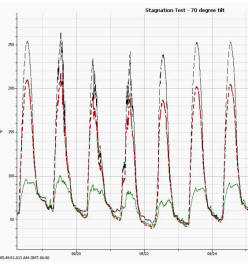 |
Drainback Test
|
One potential problem with this
collector is how well the serpentine design will drainback for freeze
protection.
This simple test looks into
this issue and indicates that drainback will not be a problem
as long as the serpentine pattern is laid out correctly, and the
collector is reasonably level.
Drainback test ...
|
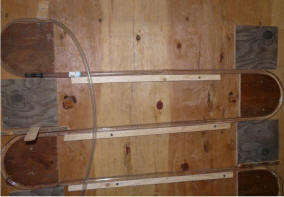 |
Tentative Conclusions and Remaining
Issues
I think that the work to date demonstrates
that it is feasible to make a collector that uses PEX tubing to convey the heat
transfer fluid. And, that if care is taken to obtain a good thermal
connection between the PEX tube and the aluminum fin that the performance of the
PEX collector is surprisingly good and quite acceptable.
The collector is relatively easy to
build, and given the materials used, should have a long life.
The collector must be protected from
high stagnation temperatures, and this deserves careful attention.
The collector is very low in cost,
and has a very high heat output per dollar spent.
My solar water heating system uses
this PEX collector and has been performing quite well since it was put in place
in September of 2008. Full details on
this system, including monthly performance plots and monthly solar fractions
here...
Be sure to also consider the
variation on this collector
that uses the same aluminum fins and attaches them the same way, but uses copper
tubing instead of PEX tubing. This design turns out to be about 12%
more efficient, and eliminates the need to be so careful about protecting the
collector from stagnation temperatures. The cost is higher at $6 per sqft, but still very
low priced compared to commercial collectors.
Update: March 2009 -- copper prices
have fallen by about 50%, and make the copper collector even more desirable
-- about $5 per sqft at current copper prices.
Gary March 23, 2008, September 23,
2008, October 4, 2008, April 8, 2009







